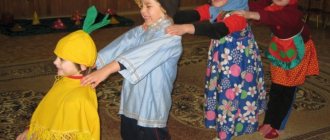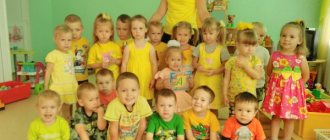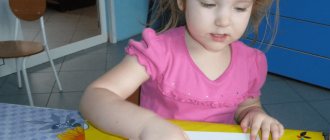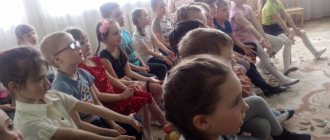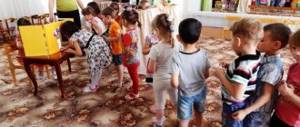Summary of GCD in the junior group with a presentation on the topic “Introduction to the profession of a cook”
Summary of GCD in kindergarten.
Second junior group. Profession cook Integration of educational areas: cognitive development, artistic and aesthetic, speech development. Purpose of the lesson : to develop knowledge among young children about the profession of a cook, to expand and enrich their understanding of labor actions and the results of labor. Program objectives: Educational
: give an idea of the profession of a cook and the items necessary for his work.
Promote the development of cognitive activity. Developmental:
continue to expand and activate children’s vocabulary on this topic.
Continue to develop the ability to roll out lumps with straight movements and connect the ends of the resulting stick. Encourage children to decorate sculpted objects using a stack. Develop fine motor skills in children. Educational
: to cultivate respect and interest in this profession of a cook.
Draw children's attention to the personal (friendly, sensitive) and business (hardworking, neat) qualities of a person that help him work. Materials for the lesson : a picture with the image of the sun, a presentation on the topic “The profession of a cook”, boards, salted dough, napkins, a stack, a spread, a doll in a cook’s clothes, special clothes for the teacher (jacket and cap). Preliminary work : looking at pictures on the topic, talking about professions.
Progress of the lesson:
Teacher : children have come to visit us, let's say hello to them (children say hello). The teacher conducts a game for psychological mood: I hold the sun in my palms, I give it to my friends! Smile - it's simple. A ray of sunshine is for you! Educator: Children, someone is knocking on our door. The Katya doll has arrived, look at her in special clothes. Let's ask why she's dressed like that. Children, I want to tell you a riddle, and you listen carefully and try to guess it. (The teacher asks a riddle and puts on a jacket and a chef’s hat) Who is the master of cabbage soup, borscht and vegetable stew? He will cook us a delicious broth, he will be able to bake a cake and fry us cutlets. Who is he? Tell me, kids. Children : cook Teacher: yes, that’s absolutely right, and our Katya works as a cook. You guessed correctly, look at me kids, I’m also wearing special chef’s clothes. There is such a profession as a cook. Do you want me to tell you about her? Then sit down on the chairs and listen. (The teacher conducts a short conversation about getting to know the profession of a cook.) A cook is a person who prepares food. In our kindergarten, women cooks work in the kitchen. They cook us delicious food. Look carefully at the picture, what is the chef wearing? Wear special clothes for preparing food. On his head is a chef's cap, jacket and trousers. Comfortable shoes on your feet (slide 2). Educator : Children, what do you think a chef should be like? The cook must be clean, always wash his hands before preparing food, and be careful not to over-salt the food or to prevent the food from burning. And also follow safety rules so as not to get burned. The cook must have a well-developed imagination in order to come up with new dishes. You must also be hardworking and love your profession. What does a chef need to prepare food? Do you need dishes? (slide 3) What do they cook their food from? (slide 4) What dishes do you know? What do the chefs prepare for you? (slide 4) Children, look, the doll is upset about something. What happened to Katya? She doesn’t have time to prepare food for the guests and asks her to help her make rolls. Shall we help Katya? Children: let us help. Teacher : come on, you and I will also turn into chefs and play the game “Funny Chef”. They circled and circled and turned into cooks. In order for us to become real chefs, we need to put on overalls (children wear aprons and caps) Finger game: We remember the dough with our hands - we squeeze and unclench our fingers.
We will bake a sweet cake -
clap our hands.
Lubricate the middle with jam -
in a circular motion across the palm.
And top with sweet cream -
in a circular motion across the palm.
And sprinkle the coconut crumbs
with the fingers of both hands.
We will sprinkle the cake a little bit And then we will make tea -
fingers with a pinch in a circular motion of both hands
We invite a friend to visit -
palms up, squeeze and unclench. Educator : children go to the tables. Today I will introduce you to flour. Touch it, sprinkle it, finger it. And now I suggest you take a piece of salt dough in your hands first - play, take the pieces, spank, press, roll, repeat after me. What do we need to create? Children : rolls Teacher : of course, rolls. See how I do it. Repeat after me. Roll out a piece of dough using straight movements and connect the ends tightly. That is, we roll the stick into a ring. Stack the pattern onto your rolls. Educator: Who came to us? What is Katya's job? What does she do (as a cook)? How did we help Katya the cook? Well done guys, you rescued the doll Katya and helped her prepare the rolls. She says thank you! Educator : Children, let’s fold the balls and take them to the kitchen to “bake” them!
Presentation on the topic: OOD on the topic “Introduction to the profession of a cook”
We recommend watching:
Entertainment for children of the preparatory group on the topic: Professions Summary of a lesson on cognitive development in the senior preparatory group of a preschool educational institution on the topic: “Everything” Summary of educational activities on speech development in the preparatory group “All works are good. Cook" Summary of a lesson in the 1st junior group on the topic "Introduction to professions." Profession: doctor
Similar articles:
Poems about professions for preschool children. Senior group
Conversation about medical workers with preparatory group children
Lesson notes for the middle group. Doctor - dentist
Lesson summary for the middle group “Profession cook”
Lesson notes for the senior group. Who is treating us
Introduction to professions
“Introducing children to the professions of adults”
Consultation for teachers
Throughout preschool childhood, while the child grows and develops, acquires new knowledge and skills,
in terms of plot - role-playing game remains the most characteristic type of his activity.
It is well known that children strive to imitate adults in their games and reproduce their actions and activities. In preschool age, role-playing games are widely used, some of them are professionally oriented. Children play by assigning themselves the roles of doctor, sellers, educators, drivers, etc.
Already in preschool age, one can make the first assumptions about the development of interest in adult work. At this age, the prerequisites for future professional activity are laid for a child.
An important area of social and cognitive development of preschool children is familiarization with the work of adults.
In kindergarten, in the family, in the public environment available to him - everywhere the child encounters the work of adults and takes advantage of its results. At first, children's attention is attracted only by external aspects. Consistent familiarization with the work of adults in the immediate environment, and then outside the kindergarten, allows them to develop an understanding of the essence and significance of labor actions, and of the social structure of life in general.
Observing the work of adults and explaining its significance in people’s lives plays an important role in the comprehensive development of a child’s personality. The work of a kindergarten has its own difficulties in developing interest in the work of adults: a significant part of the work of adults does not take place in front of children, and the possibilities of observing their work are limited. Therefore, it is necessary to find ways and forms for preschoolers to approach the work of adults, showing its social significance, the essence of labor actions, the results of labor, and to determine the conditions for the most effective influence of adult labor on the formation of imaginative ideas about it.
The main source that fuels a child’s play is the world around him, the life and activities of adults and peers. In a plot-role-playing game, the child’s knowledge and impressions do not remain unchanged: they are replenished and clarified, qualitatively changed, transformed.
In the preschool years, children show a keen interest in the work of adults and strive to imitate them in play and everyday life. Therefore, it is necessary to create conditions under which children could use life-giving examples of adult behavior.
Skillful selection of the content of a lesson to familiarize yourself with the environment is a very important factor in the development of interest in adult work in preschool children.
At the same time, it is very important how this content is brought to the consciousness of children, what techniques the teacher uses.
To ensure systematic work, we have developed a scheme to familiarize preschoolers with the work of adults and consolidate the acquired knowledge in a role-playing game:
1. Reading fiction, listening to songs, audio recordings
2. Conversations about the profession, looking at illustrations
3. Excursion, watching videos
4. Organization of interaction with parents: entertainment with the invitation of parents, consultation for parents, parent corner
5. Story-role-playing game
The most intelligible and convincing are living images, a true example of the professions of adults. Visibility of life (observations, excursions) ensures the greatest clarity of ideas and maximum effectiveness of the knowledge acquired by children. What is visually perceived, however, requires interpretation. In the process of further conversations, through the teacher’s stories, the information obtained during observations is clarified, consolidated, and supplemented.
When developing children's interest in adult work, educators, as a rule, use visual methods, skillfully combining them with verbal ones (stories, conversations); the proportion of the latter may increase when working with older children. A special place among verbal methods is occupied by the use of children's fiction.
Reading works of fiction plays an important role in developing children’s interest in the work of adults. With its emotionality, imagery, and liveliness, a children's book infects children with enthusiasm to get acquainted with the professions of adults: it awakens interest, respect for work, the desire to imitate the heroes of literary works, like them, to work well.
The most effective ways to familiarize children with the work of adults are through observations and excursions. It is very important to select for observation those types of work that are educationally valuable, the content of which is understandable to children, and makes them want to imitate the work behavior of adults.
When developing interest in the work of adults in children, it is very important to be gradual in expanding information. It should be borne in mind that the abundance of impressions leads to the fact that children receive fragmentary, superficial information; having little impact on the formation of the right attitude towards work, on the development of labor skills and abilities.
In the process of observing the work of adults, it is necessary to give a small amount of information, gradually expanding and deepening it, supplementing what is known with new knowledge, consolidating the old. Only with such a gradual deepening of children into a cognizable phenomenon is it possible for them to develop the correct ideas about the professions of adults, the correct attitude towards it.
Familiarization with the work of adults and children’s own activities should be closely intertwined.
Game is a historical activity of children, which consists in reproducing the actions of adults and the relationships between them. Work is closely related to play. In play, children reflect the work of adults.
The choice of professions that teachers introduce children to is determined by the following factors: the age of the children, the professions of the parents of the group, the interests of the children, social facilities near the kindergarten (shop, pharmacy, hairdresser, post office, savings bank).
Undoubtedly, the most spectacular and effective way to get acquainted with the work of adults is an excursion:
at the pharmacy, children were introduced to the names of devices (tonometer, phonendoscope); at the hairdresser, children saw unusual scissors and various devices for styling hairstyles.
Another way to get acquainted with the work of adults, which is not used often, but is no less effective than an excursion, is inviting guests.
A fire truck on the territory of the kindergarten and meeting real firefighters made an indelible impression on the children.
The work of introducing professions is very interesting for both children and adults. Teachers, preparing material for children, learn a lot of new things themselves.
